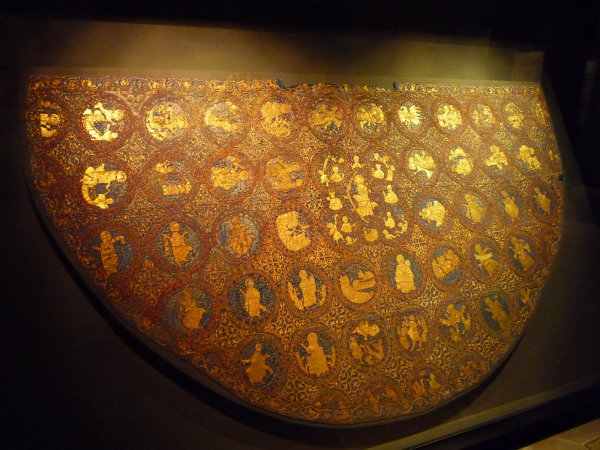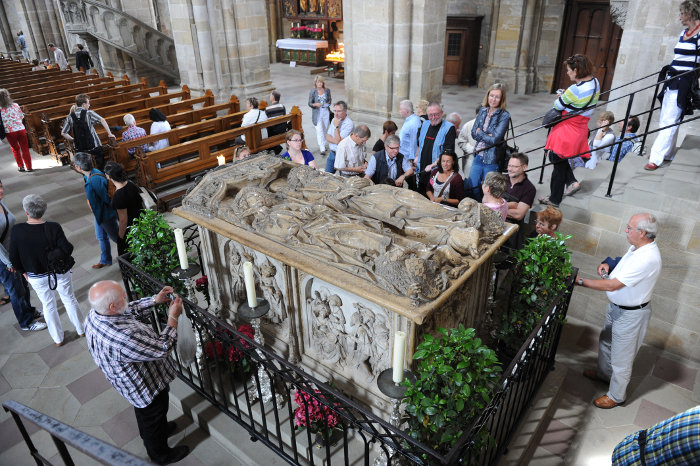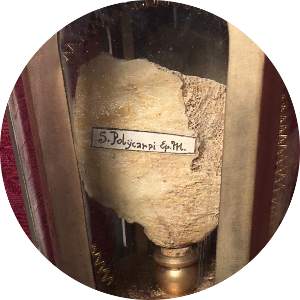Spouse of Holy Roman Emperor Saint Henry II. (+ 1040 A.D.)
Saint Cunegunda of Luxembourg, OSB (c. 975 - 3 March 1040 at Kaufungen), also called Cunigundes, Cunegunda, and Cunegonde and, in Latin, Cunegundis or Kinigundis, was Empress of the Holy Roman Empire by marriage to Holy Roman Emperor Saint Henry II. She served as interim Regent after the death of her spouse in 1024. She is a Roman Catholic saint and the Patroness of Luxembourg and Lithuania; her feast day is 3 March.
St. Cunigunde was one of eleven children born to Siegfried I of Luxembourg (922 - 15 August 998) and Hedwig of Nordgau (c. 935 - 992). She was a seventh-generation descendant of Charlemagne. She married St. King Henry in 999. It is said that she had long wanted to be a nun, and that her marriage to St. Henry II was a spiritual one (also called a "white marriage"); that is, they married for companionship alone, and by mutual agreement did not consummate their relationship. It has been claimed that Cunigunde made a vow of virginity with Henry's consent prior to their marriage. The truth of this is debatable; while the couple were both certainly childless, it is supposed by some authors that later hagiographers mistakenly construed the fact to imply a virginal marriage. Others, however, accept that the marriage was purely platonic.
During their marriage, her husband, Henry, then only Duke of Bavaria, was crowned as King of Germany ("Rex Romanorum") on 9 July 1002 in Mainz, in present-day Germany, by Willigis, Archbishop of Mainz. After her husband was crowned as King of Germany, she was crowned as his Queen (consort) of Germany on 10 August 1002 in Paderborn, in present-day Germany, also by Willigis, Archbishop of Mainz. Later her husband was also crowned as King of Italy ("Rex Italiae") on 14 or 15 May 1004 in Pavia, Italy, but no evidence has been given of her being crowned as his queen consort of Italy.

Pictured above is the magnificent mantle of Empress Saint Cunegond, spouse of the Holy Roman Emperor Saint Henry II. It was eventually which was also used as a cope in Bamberg Cathedral. It shows the history of Salvation through the Old and New Covenant (within 40 medallions), at the center Christ is seen within a Byzantine Mandorla. (Image source: http://www.newliturgicalmovement.org)
It appears that Cunigunde was active politically. As the closest adviser of her husband, she took part in Imperial councils. She is also reported to have exerted an influence on her husband in his endowments of land to the Church. These included the cathedral and monastery at Bamberg, Bavaria, in present-day Germany.
Cunigunde traveled with her husband to Rome for his coronation as Holy Roman Emperor ("Romanorum Imperator") as was the tradition for the King of Germany, and was crowned as Holy Roman Empress with him on 14 February 1014 in St. Peter's Basilica, Rome, receiving together with Henry the Imperial Crown from the hands of Pope Benedict VIII. During her reign she suffered from a grave illness and made a vow that if she were to regain her health, she would found a Benedictine monastery at Kassel. Upon her recovery, she kept her oath and work began on the building; however, Henry died in 1024 before it was finished. Upon his death, Cunigunde was obliged to assume the office of Regent of the Empire. This she did with her brother, and later handed over the Imperial insignia when Conrad II was elected to succeed her late husband on 8 September 1024.
Religious life and death
As a widow, St. Cunigunde was left comparatively poor, owing to the enormous wealth given away by her and Henry in charitable works.
In 1025, exactly one year after the death of her husband, St. Cunigunde retired to Kaufungen Abbey, in Hesse, Germany, where she entered the monastery of Benedictine nuns she had founded there. At the dedication of the monastery, she offered a relic of the True Cross, removed her regalia, and donned the habit of the nun. There she remained at the monastery, performing charitable works, caring for the sick and devoting her time to prayer.

Hair relic of Saint Cunegunda (above), which is encased among numerous other holy women and men available for veneration by the Faithful at All Saints Shrine within Sacred Heart Byzantine Catholic Church, Livonia, MI.
She died 3 March 1040 A.D. She was buried at Bamberg Cathedral beside her husband, but may have been buried elsewhere first and then eventually re-interred at the Cathedral in 1201 after her canonization (as pictured, below).

Hagiography source: https://alchetron.com/Cunigunde-of-Luxembourg




